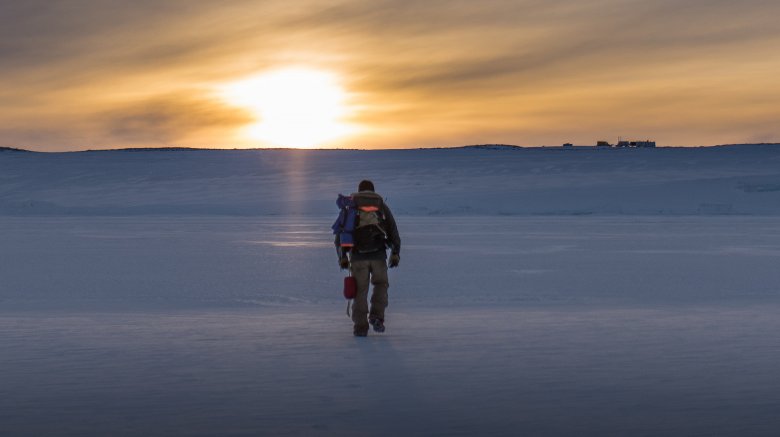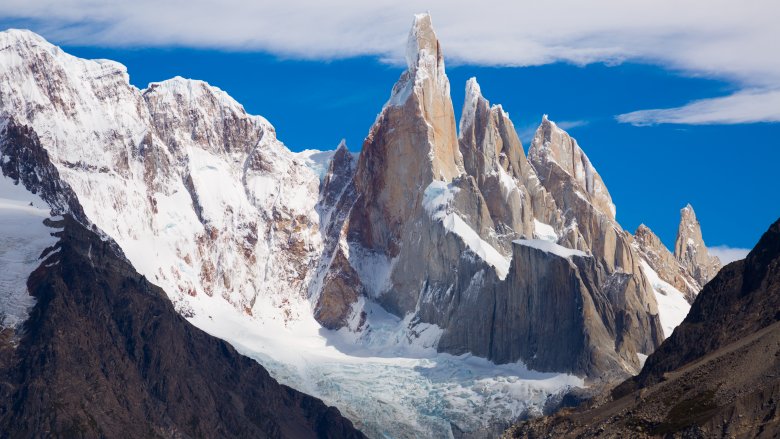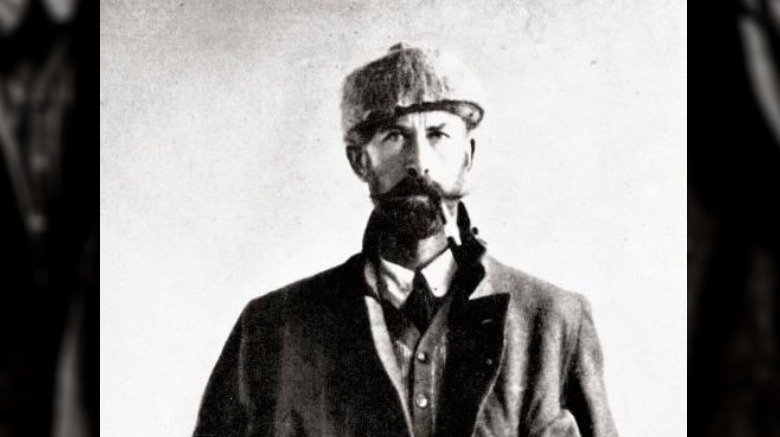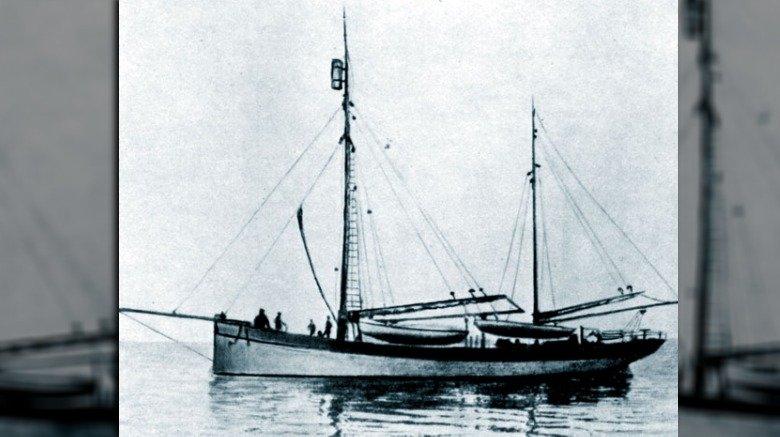Scientists Who Are Still Missing Today
Death on the job is a reality for a lot of professions, but going missing on the job is a bit more unusual — unless you're a scientist, and your job involves exploration of remote places, trekking through the wilderness, or upsetting people with end-of-the-world theories. Or if you just like to go on crazy, exotic vacations by yourself.
Scientists tend to be more adventurous than the average politician, social worker, or computer programmer, which means history is full of stories of intrepid explorers, archaeologists, geologists, and people who were just hoping to go down in history as the person who discovered something big. And sometimes those people had to venture into places where few people have gone before, places so remote that when the unthinkable did happen, the rest of the world was left with an unsolvable mystery.
Of course not all missing scientists vanished in the line of duty — some of them vanished on their days off and some of them probably vanished on purpose. Here's a list of a few (more or less) modern scientists who are still missing today.
Don't be a scientist in Soviet Russia
The trouble with being a scientist is there's always going to be someone who doesn't like what you're doing and who really doesn't want you coming out with ideas that might change consumer behavior or influence regulations. In the West, it's less likely that your unpopular theories will get you disappeared, but all bets are off if you're working within a less-than-democratic nation.
According to Time, in 1985, a Soviet physicist named Vladimir Alexandrov was visiting Madrid when he vanished. Alexandrov wasn't just any physicist (as if there's such a thing as "just any physicist") — he came up with the mathematical model for nuclear winter. Without the contributions of Vladimir Alexandrov, we might not have the full, terrifying concept of the descending darkness that would accompany full-scale nuclear war, and therefore no bleak, depressing post-apocalyptic movies starring Viggo Mortensen.
So what happened to Alexandrov? He was in Madrid, so there's a possibility he might have defected, which would explain why he was never heard from again. More conspiracy-minded people think the whole nuclear winter idea might have been heavily promoted by Russia, designed to convince activists in the United States to protest America's nuclear weapons programs. This theory says Alexandrov was kidnapped by the KGB because he was planning to tell the world the nuclear winter theory was actually bunk. Like so many other stories of mysterious disappearances, though, we won't know until Alexandrov either comes out of hiding or rises from the dead.
Don't go hiking alone in southern Chile
Sometimes scientists disappear for non-conspiratorial reasons. Yes, that's just shockingly boring, but "got lost while hiking" is really a lot more plausible than "was kidnapped by people who don't like math" or "got abducted by aliens who want to learn algebra." At any rate, one such disappearance was the case of Boris Weisfeiler, a mathematician who decided one day that Pennsylvania winters were just too danged warm so he was going to go hiking in the mountains of southern Chile.
According to the BBC, the last time anyone saw or heard from Weisfeiler was in January 1985. Not long after that, his backpack was found next to a river. Chilean authorities concluded he drowned while trying to cross.
LIke all great mysteries, though, there were people who said otherwise. In 2000, documents came to light that suggested Weisfeiler might have been abducted and murdered. The evidence was damning enough that eight people were arrested and charged with the kidnapping, but the judge eventually closed the case and set everyone free, citing statutes of limitations. So the mystery is still unsolved, and the only thing we know for sure is it's probably a bad idea to go hiking alone in the foothills of southern Chile.
Don't visit carnivorous deserts
The most common way for a scientist to vanish appears to be in the line of duty, which is actually pretty fitting and not so terrible, especially from a poetic perspective. That's what happened to Peng Jiamu, a biologist at the Shanghai Institute of Biochemistry and Cell Biology. According to China Daily, in 1980 Peng led an expedition into the Lop Nur desert, a dangerous landscape full of soft riverbeds and shifting sand dunes, which made for treacherous traveling conditions. On June 17, the team was running low on vital supplies, so Peng walked out of camp, leaving only a note to inform his companions that he was going to go look for water. But he never returned.
Chinese leaders diligently searched for Peng, sending planes, helicopters, police, dogs, and literally hundreds of soldiers to scour the landscape. But Peng had completely vanished.
Peng's colleagues don't seem to find his disappearance as mysterious as the public did — the Lop Nur landscape is almost carnivorous, and the idea that it could swallow someone up without a trace is certainly not fantastic. Point: Entire hillsides in the Lop Nur desert sometimes collapse, burying travelers and whatever other unfortunate creatures might be passing by. The search team even located a missing camel that had been almost completely buried by shifting sands. And other expeditions find bodies in Lop Nur all the time — though to date none of them have turned out to be Peng.
Only sort of disappeared
New Zealand cardiologist J.C.P. Williams noticed that a lot of kids visiting his practice shared some characteristics — in addition to their cardiovascular problems, they also had similar facial features and were especially friendly and outgoing. Today we call this genetic disorder Williams syndrome, after the doctor who identified it and then disappeared less than 10 years later.
Often, the only person who can say what led to a disappearance is the missing person, so it's impossible to do much more than speculate about some cases. But Williams seems to have voluntarily disappeared, and it was probably because of a spurned marriage proposal.
Michael King's book Wrestling with the Angel says Williams was living with New Zealand poet Janet Frame in the late 1960s. When he proposed marriage in 1969, Frame literally ran away, and when she finally returned a week later, Williams had vanished. But unlike many of the people on this list, he wasn't technically gone — in 2011 Pediatric Radiology said friends recalled meeting him in Austria in the mid-1970s, and even though his sister had the High Court of New Zealand declare him "a missing person presumed to be dead from 1978," there is evidence he might have been alive as recently as 2000. If those things are true, then Williams is likely one missing person who would really just prefer to remain missing.
Bring an extra cramper
There are a few things you should learn here, but the big one is this: Don't go off into the wilderness by yourself, especially if you're a prominent scientist.
In this tale of adventure gone terribly, terribly wrong, a geologist and planetary scientist named Thomas A. Mutch vanished in 1980 while descending a 23,000-foot peak in the Kashmir Himalayas. According to the American Alpine Club, he was last seen "on a precarious ledge" just after losing a crampon, which is kind of like an iron maiden for your shoes. He couldn't come down without the crampon, so one of his two companions went to find a spare and when he returned, Mutch was gone.
Before his disappearance, Mutch was the Associate Administrator for Space Science at NASA and the author of two books on the geology of the Moon and Mars. He was also involved in the Viking mission to Mars as the lead for the Lander Imaging Team. After his disappearance, NASA honored him by renaming the Mars Lander the "Thomas A. Mutch Memorial Station." Mutch's body was never recovered.
Don't upset any elites
Dor Bahadur Bista was fond of trekking off alone into the wilderness where he could conduct his research in private, unencumbered by pesky people who could help him in an emergency or inform his family where he'd gone. According to ECS Nepal, Bista was an anthropologist of great acclaim — today he's remembered as the father of Nepalese anthropology. He was known for his work with Thakali traders in the upper Kaligandaki river valley and as a professor at Tribhuvan University in Nepal.
In the weeks before his 1995 disappearance, friends said he was fretting over some negative responses to a book he'd just published. He had some enemies, too — elites who were annoyed by his efforts to help empower lower-class Nepalese. He confided to one friend that he felt threatened and was considering leaving Nepal for his own safety. Then, a few weeks later, he was seen boarding a bus. After that his trail went cold.
Now to be fair, he was known for doing research alone in remote places, but he was an anthropologist, so it's unlikely he would have been conducting research in places totally devoid of other humans. And he did tell his friend that he felt like his life was in danger, which seems incompatible with a solo trek into the wilderness. Hopefully that bus took him somewhere safe and he lived the rest of his life studying the strange behavior of American tourists — a relatively safe scientific pursuit, comparatively speaking.
Don't go sailing alone
Jim Gray went on a sailing trip in 2007 and was never seen again. Oh and guess what, he was alone.
Gray set off in sunny weather on a voyage that was only supposed to take one day. When he didn't return that evening, his wife reported him missing.
According to the New York Times, the Coast Guard searched 132,000 square miles of ocean for four days but found no trace of the Turing Award-winning Microsoft researcher's 40-foot sailboat. Gray's friends and colleagues weren't about to give up, though. They wrote software to help volunteers sift through thousands of satellite images in search of Gray's red and white boat, and they enlisted the help of Google Earth satellites. The NASA Ames Research Center even volunteered to steer a high-altitude aircraft over the search area.
Despite all its technology and the tenacity of participants, the weeks-long search turned up nothing, so Gray's wife hired an underwater search team to scan the ocean floor. That search also turned up nothing. Some people think the boat sank and fell over the continental shelf, where it would be impossible to find. But there aren't any good theories to explain why the boat might have gotten into trouble in the first place, especially considering the good weather and its captain's extensive experience. Five years later, Gray's wife had him declared "missing but presumed dead," which at least must have given her a small sense of closure.
Cockroach pheromones aren't worth dying for
In July 1994, Ernst Priesner went out into the Bavarian Alps — by himself, of course — to check some traps. He was never heard from again.
Priesner was a well-known biologist who was interested in pheromones, collaborating on some of the great works on the subject, like Olfactory Receptor Response to the Cockroach Sexual Attractant and Wind-tunnel study on attraction inhibitor in male Coleophora laricella Hbn. So, probably really important stuff? Sounds impressive.
Anyway, Priesner was checking pheromone traps when he vanished. Search parties failed to locate him, and his colleagues concluded he'd met with some kind of accidental death, and then proceeded to divide up all of his stuff.
We don't actually know for sure what happened to him, though, as he went off into the wilderness by himself with no witnesses and no one to come back and tell his friends and family about his unfortunate fate. So not only is Ernst Priesner still missing today, but his work has been set back until someone else steps up to the plate so we can better understand how and why cockroaches get it on, and stuff. And that's a shame.
The man who inspired 100 suicide missions
Technically, this dude is dead. Because he vanished nearly 100 years ago and even if he ended up living in a luxurious jungle palace where he ate only vegetables and seafood and never developed cancer or scurvy or fell on anything sharp, he still died of old age some time between 1947 and 1987, if you're being optimistic. But he is still missing because no one has found his body or any trace of him since he disappeared in 1925.
Percy Fawcett, besides having the most English name of all time, was a geographer and archaeologist searching for the City of Z, a lost civilization he believed was hidden somewhere in the Amazon. In 1925 he entered the jungle with two companions, two laborers, and a ton of supplies. He was never heard from again after a final letter sent to his wife sent a month after entering the jungle.
No one could believe he'd just vanished without a trace — somewhere out there was a body, or maybe even a live man who'd decided to abandon everything he knew so he could live in the jungle and make friends with mosquitos. Fawcett was never found, but his lost City of Z kind of turned out to be a real thing. Since his failed expedition, archaeologists have discovered huge cities of stone fortified by walls hidden within the jungle, not too far from where he disappeared.
Summit fever on the high seas
People who try to climb Mount Everest sometimes die from "summit fever," which is a sort of psychosis. If you're stricken with summit fever, nothing will dissuade you from the summit, not even life-threatening illness, because Everest is your dream, and dang it, it cost you a lot of money to get there. Many people who develop summit fever on Mount Everest die there.
But summit fever isn't just something mountaineers get. Throughout history, just about every explorer or scientist with a dream gets some version of summit fever, whether it's lost city fever or desert fever or cockroach pheromone fever. For Russian geologist Vladimir Rusanov, it was Northern Sea Route fever. According to Russian Arctic Seas: Navigational Conditions and Accidents, after a successful expedition into Svalbard in 1912, Rusanov and 11 of his crew decided to sail to the Pacific Ocean via the Northern Sea Route, which was by all accounts kind of a stupid idea. The last communication from the ship was a telegram on September 27, 1912, in which Rusanov said he planned to sail east across the Kara Sea.
A couple ships went out in search of Rusanov in the years that followed, but the closest anyone ever came to learning the fate of the ship was a few "personal effects" found on Popova-Chukchina Island, and a wooden column on another island inscribed with the ship's name, "Gerkules." The ship itself was never found, and neither was the crew.










